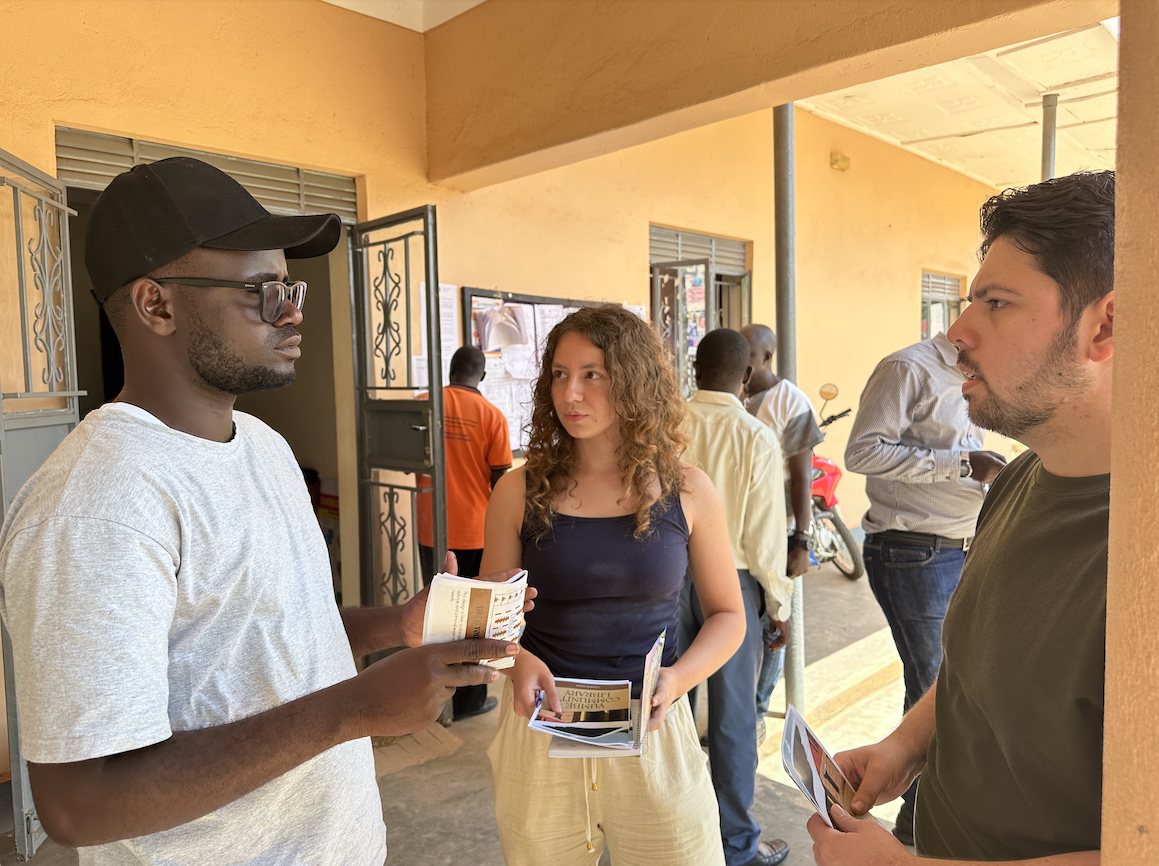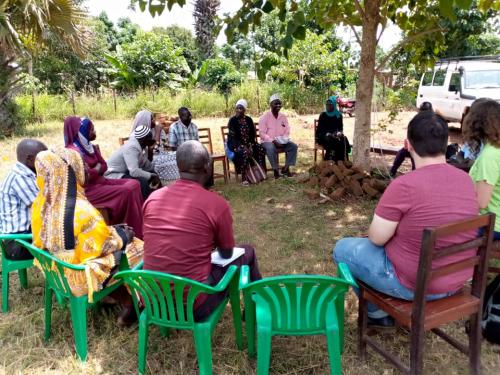In Uganda, a child starting school at four years old is only expected to complete 6.8 years of schooling by their 18th birthday. To reverse this trend, the non-governmental organization (NGO), Nested Savings, transformed an old building into the first and only library in Yumbe, Uganda, giving community members a place to study and work with access to electricity and educational resources. Despite being slightly larger than a shed and housing a single computer, the library serves around 15,000 people. Since its creation, it has helped Yumbe students place in the top percentile of the country’s standardized tests for the first time.
To build on the progress achieved by the community library, members of GW’s Engineers Without Borders (GW EWB) Chapter have designed a plan to expand on the existing structure and build a full learning center. This center will feature a computer lab, conference room, Early Child Development Center, quiet study spaces for both groups and individuals, and rainwater collection and filtration systems. Mechanical Engineering Juniors Isabella Elmore and Tamar Todd are co-leading the project. Contingent upon sufficient funding, they and fellow team members will travel to Yumbe in December to implement this structure.
Yumbe, located in the West Nile region of Northern Uganda, still grapples with the lingering effects of a series of civil wars from 1979 to 2008, which disrupted familial and societal structures and hindered the region’s development in meeting basic needs. With Yumbe’s young population, where 55% are under 18 years old, and an influx of over 270,000 refugees, mainly from South Sudan, resources for after-school work or continual education are stretched thin in this community.
Nested Savings introduced the idea of this library in 2016 as part of a livelihood improvement project led by Yumbe’s central government to expand educational opportunities. GW EWB adopted the project in 2019 after being partnered with the NGO by their parent organization, Engineers Without Borders-USA (EWB USA). Following the pandemic, they began design iteration and cultural research and, in August 2023, members Elmore and Jacob “Jack” Hatcher traveled to Yumbe for an assessment trip to receive community input on their design.
“There are really three motivations for why we went overseas,” said Elmore. “We wanted to ensure the longevity of the project, that it is something people want and will use, and that it will make a difference in the community.”
Elmore and Hatcher spent 10 days interviewing members of the Yumbe community to tailor each feature of the center to the community’s self-identified needs, discussing topics such as day-to-day needs, educational experience and inhibitors, cultural barriers, impacts of climate change, desired skills and knowledge, and more. Elmore said they are very fortunate to work with Nested Savings as they are well-integrated into the community, which allowed them to speak with women, educators, elders, religious leaders, government officials, and refugees to get a holistic view of the complex Yumbe community.
“Every new person we talked to asked if we were missionaries. They had never seen engineers from the West or a female engineer. It was very surprising,” said Elmore. “There is something about going to a school and having a young refugee girl come in talking about a club she wants to join, then telling her that I’m an engineer and seeing this sort of aha moment of, ‘I didn’t know that was possible.’”
In total, the GW EWB team working on the Uganda project comprises 10 to 15 students who collaborated to transcribe these interviews and incorporate community requests into the learning center’s design. For example, women mentioned the library not having a place to bring their kids, leading them to the idea of adding an Early Child Development Center. Todd said that in any area of conflict women and children are affected the most, so this room will allow them to use the facilities of this center without sacrificing their duties as mothers.
Another prominent community concern is water access at the learning center. The water access on the current lot of land comes downhill from latrines, raising concerns about the spread of diseases like gonorrhea and malaria as it is the only available water source. Todd said Uganda gets about 40 to 60 inches of rainfall a year so it’s not like water is not abundant, they simply lack a place to collect and filter it. However, the group’s inverted truss roof design addresses this issue by providing a solution for collecting and filtering rainwater.
“In our design, all rainwater will flow down into a central gutter and then it can be collected into and filtered through a big rain barrel so they'll have access to clean drinking water throughout the entire year,” Todd stated.
In addition to a population-centered design, sustainability is crucial for EWB projects. GW EWB adopted an innovative approach for an international group by blending American and Ugandan foundation practices to build the structure, which Todd said is one of the main ways their design is sustainable from a construction standpoint. To accomplish this and ensure it still meets standards, the group collaborated with two professional engineers Jesse Bluestein, the Responsible Engineer in Charge from EWB USA, and Andrew Vuuchi, a civil engineer based in Uganda.
“By working with those two gentlemen, and a lot of the civil engineering department at GW as well, we came up with this great idea to completely hybridize both of those building styles and to essentially rely on and trust the knowledge and experimentation that people in this region have been doing for decades,” Elmore said.
Additional ways the group’s design prioritizes sustainability are by incorporating features such as strategically placed air pockets within the brick walls that allow for natural airflow, promoting self-cooling without reliance on electricity. The entire structure will be powered by solar energy for which GW EWB will create videos covering how to clean, repair, and replace. The videos will be tailored to the dialect of English spoken in Yumbe so the project will be self-sufficient after construction.
As part of their commitment to enhancing access to technology, the team organized an event for Engineers’ Week 2024 where they built and refurbished six personal computers, two of which were built from scratch, to be used in the computer lab. Elmore says having access to the internet will be game-changing in the Yumbe community’s ability to learn new agricultural techniques to adapt to fluctuations in weather induced by climate change.
Building the structure itself is not too expensive but accommodating travel costs for members to get to Uganda later this year, making the structure sustainable, providing access to clean water, and incorporating additional requests Todd said adds up quickly. The extra efforts GW EWB is making demonstrate how they are going above and beyond to aid the community as much as possible through this learning center but exceed the scope of traditional EWB projects, according to Todd.
“Our goal is to build just the structure. With that being said, this project has definitely become a passion project for me, Isa, and everyone on the team. If we can provide some of the extra materials they requested, we really want to,” Todd stated.
GW EWB’s overall budget to build the entire structure with all features outlined above is around $55,000. Fundraising efforts are ongoing and come from various sources, from grants to bake sales in Kogan Plaza. Todd says to think of it as $1 amounts to 16 bricks to build the structure, making the overall goal feel a bit more attainable. From there, $50 pays for a student visa to travel abroad, $200 buys all of the bricks for the computer lab, and $1,000 pours the foundation for one room.
Considering the impact of the current 20-seater library, even constructing just the computer lab could make a significant difference in this community. Scaling the plan back to build just half of the building or solely the computer lab, Elmore said, will make all of the other rooms possible. Ultimately, this learning center offers the Yumbe community a potential solution for the staggering illiteracy rates and low primary school retention rates in the West Nile Region of Uganda.
For GW EWB members, Elmore says being able to travel to Uganda and oversee the construction of this structure will be a life-changing experience. “It will have a big impact on our team, who are all young engineers and mostly women, to have this opportunity to be completely compassionate in how they look at their education. To see that they’re not just doing things for the purpose of homework problems or theoretical work, but what they learn in class, point A leads to point B, which is a building in Uganda.”





